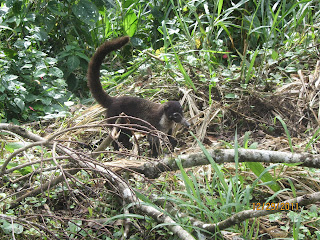Travel day, 12-29, part 1
11:08 PM
Ok, this was a long, interesting day of travel, leaving La Fortuna at 8am, headed toward Monteverde. Erick projected a 4-hour trip, with lots of qualifications about the roads. He also gave us the option of one stop or two, and I quickly urged two official stops. I've found I enjoy those "between places" about as much as many of our formal activities, in country after country. Let's see how it went...
We started the long circle around Lake Arenal, with a history of why this lake is here. It seems that in 1968, the Arenal Volcano had a major eruption, destroying several towns, killing people, and the government decided that they just couldn't move back there (somewhat more efficiently than we deal with flood zones), and so they moved the towns and built a dam. It is used mostly, Erick says, for hydroelectric power (so more Bagnell Dam than Glen Canyon, I suppose), along with activities such as jet skis and kayaking (Wait! kayaking? let's go back). In an eery twist, when the Lake lowers in dry season, sometimes parts of the old towns rise, ghostly, from the water. It is a pretty lake, the side we're on off-limits to development.
But history is interrupted for our first unplanned stop, to gawk at 6 howler monkeys munching on the upper leaves of a cecropia tree:
We pass some 'common bamboo' and stands of eucalyptus trees, and Erick points out that both of these are invasive, alien species. The government is actively trying to eradicate eucalyptus, and restore native tree species.
8:40 a.m. But ecology is also interrupted, this time for 3 coatimundi (or coati, or in Spanish, pizote). They look cute, look eager to good investigate us for food, but we have been warned they can be aggressive and painful.
Before long, we actually do arrive at the first planned stop, in Nuevo Arenal, one of the moved villages. We stop at the German Bakery, which is actually run by a German couple. Mary was delighted to practice a bit of Deutsch, and I had managed to survive to this next oasis of coffee. Allison found a friend:
and several folks found more souvenirs.
Back on the bus, we heard about the windmills coming up soon, to your left--
And we learned more about Costa Rica's plans. Their new president (their first female president) has pledged that Costa Rica--the whole country--will be carbon-neutral within the next few years. Will extensive wind and hydroelectric power (and little need for heating or AC), they might make it. Back home in the U.S., well, we're behind. We need to plant an awful lot more trees, and maybe figure out a few more things.
later, bob
We started the long circle around Lake Arenal, with a history of why this lake is here. It seems that in 1968, the Arenal Volcano had a major eruption, destroying several towns, killing people, and the government decided that they just couldn't move back there (somewhat more efficiently than we deal with flood zones), and so they moved the towns and built a dam. It is used mostly, Erick says, for hydroelectric power (so more Bagnell Dam than Glen Canyon, I suppose), along with activities such as jet skis and kayaking (Wait! kayaking? let's go back). In an eery twist, when the Lake lowers in dry season, sometimes parts of the old towns rise, ghostly, from the water. It is a pretty lake, the side we're on off-limits to development.
But history is interrupted for our first unplanned stop, to gawk at 6 howler monkeys munching on the upper leaves of a cecropia tree:
We pass some 'common bamboo' and stands of eucalyptus trees, and Erick points out that both of these are invasive, alien species. The government is actively trying to eradicate eucalyptus, and restore native tree species.
8:40 a.m. But ecology is also interrupted, this time for 3 coatimundi (or coati, or in Spanish, pizote). They look cute, look eager to good investigate us for food, but we have been warned they can be aggressive and painful.
and several folks found more souvenirs.
Back on the bus, we heard about the windmills coming up soon, to your left--
And we learned more about Costa Rica's plans. Their new president (their first female president) has pledged that Costa Rica--the whole country--will be carbon-neutral within the next few years. Will extensive wind and hydroelectric power (and little need for heating or AC), they might make it. Back home in the U.S., well, we're behind. We need to plant an awful lot more trees, and maybe figure out a few more things.
later, bob






Post a Comment